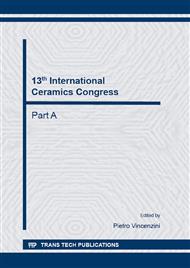p.85
p.91
p.98
p.105
p.113
p.118
p.126
p.132
p.139
Manufacturing of Porous Ceramic Spheres Using Calcium Phosphates, by a Mechanical Method without Additives or Binders
Abstract:
The processing of porous ceramics spheres (PCS) has been developed for biphasic calcium phosphates (BCP), hydroxyapatite (HAp) and beta tricalcium phosphate (β-TCP) in order to be used mostly as bone fillers and drug delivery systems. The importance of the PCS is due to better accommodation of them in order to fill empty spaces and also because is more friendly to cells and bone tissue growth. Also is important to obtain a surface roughness to increase the surface area in contact with the living tissue and their fluids. There are several methods used to achieve the PCS form and most of them use suspensions based on liquids immiscibility effect or additives. The aim of this work was to achieve PCS of BCP, HAp and β-TCP with rough surface and varying size without using solutions or additives. The method developed is based on a mechanical continuous movement of the particles, relying on the normal ability of the ceramic powders to aggregate themselves while rolling in a cylindrical container for long periods. The physical forces involved in the process, gravity, particle attraction, centripetal force and shocking make the ceramic rounds with golf ball appearance on its surface. With this method it was possible obtain PCS with 30% of porosity with rough surface and size between 1 to 4 mm in diameter.
Info:
Periodical:
Pages:
113-117
Citation:
Online since:
October 2014
Keywords:
Price:
Сopyright:
© 2014 Trans Tech Publications Ltd. All Rights Reserved
Share:
Citation:


